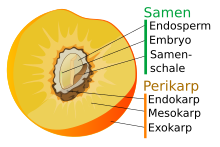Stone fruit
Stone fruits are closing fruits in which the seeds are surrounded by a woody core . The exocarp is membranous, the mesocarp fleshy or leathery-fibrous, while the endocarp forms the woody shell of the usually only stone in which there is often a seed, but it can also contain several seeds. The stone is also known as the pyrene or the stone shell (endocarp) as the putamen . But it can also contain several stone cores as with some species.
In most cases there is a connection with an adaptation to endozoochoria , the spread of seeds by fruit-eating animals. The seed is protected from damage by the lignified endocarp, the inner layer of the pericarp. Around it, the outer layers of the pericarp, the meso- and exocarp, form fleshy, juicy parts made up of living cells. These are not always edible for humans (for example with the coconut ).
Stone fruits include:
- with edible pulp: mango , mirabelle plum , nectarine , peach , plum , plum , apricot , olive , sour cherry , sweet cherry , cornel cherry
- with edible seeds or endosperm (seed nutrient meat ): coconut , almond , peach (for persipan ) and pistachio
Special forms are the collective stone fruit , such as B. the blackberry and the raspberry and the stone fruit association (z. B. fig , jackfruit ).
The “coccum” is also a special form, it is formed from just one carpel and opens along two seams, it stands between an opening stone fruit or a capsule and a legume. Also because the term legume stands for the fruits of legumes, a differentiation is necessary. It comes z. B. in the nutmeg family and in the silver tree .
There are very seldom winged stone fruits as in Coffea pterocarpa .
See also
Individual evidence
- ^ Michael G. Simpson: Plant Systematics. Academic Press, 2006, ISBN 978-0-12-644460-5 , p. 386.
- ^ GW Bischoff : Dictionary of descriptive botany. Schweizerbart, 1839, p. 163, limited preview in the Google book search.
